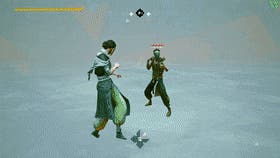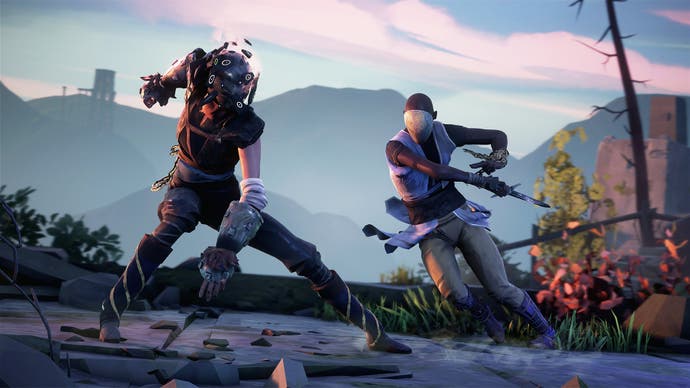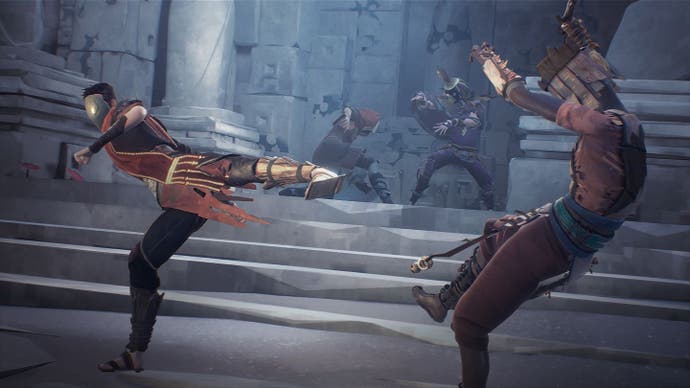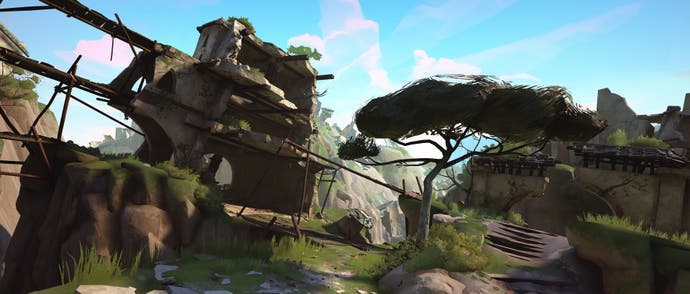The neverending quest for Absolver's ultimate martial art
How players have made the most of Sloclap's unique build-your-own combat system.
You've heard of the Way of the Dragon, but have you come across the Way of the Magic Right Arm? As you've probably guessed, it's a martial art where every move has to involve the right arm - effective at rattling jaws, less so at sweeping ankles. It's not, you've probably also guessed, an actual combat discipline but one of thousands dreamt up by players of Sloclap's Absolver, the unbearably stylish fighting game which lets you pick from over 120 beautifully animated kicks and punches to create a bespoke martial art, or "deck", of up to 16 moves.
Launched in 2017, Absolver's idyllic open world and RPG trappings such as looting are a little deceptive. This is a duelling simulation above all and as such, many player-created decks are works of painstaking optimisation, born of hours spent weighing up frame counts and hit ranges. There are plenty, however, that are more whimsical than competitive, and the game would be much poorer without them.

Some decks are purely about showing off, stringing together high-stakes moves like the MeiaLua, a grandiose kick which begins with you pointing your arse at your opponent's head. Others trade on creative handicaps, such as boxer decks that keep your feet firmly on the ground. There are monkish decks that seek to recreate as closely as possible the martial arts (including Kung Fu and Jeet Kune Do) from which Sloclap took inspiration. At the sillier end of the scale are decks which only use moves that spin you clockwise, and "Chad decks" - as lovingly described by r/absolver member Morklympious - which chain together meaty hits with wind-ups so exaggerated you might as well be fighting in slow motion. They're guilty pleasures for veterans looking to blow off some steam.
There are quite a few of those veterans knocking around - still writing guides and sharing tips on Discord and Reddit for a small but dedicated playerbase now split across PC, PS4 and Xbox. This is heartening given that Sloclap ceased support for Absolver in spring last year, a few months after shipping the game's first and final expansion, Downfall. A tiny French outfit helmed by Ubisoft alumni, the developer is hard at work on its second, unannounced game (not, its co-founders tell me, an Absolver sequel), but Absolver soldiers on thanks to the brutal alchemy of deck-building, which has fostered an atmosphere of good-humoured rivalry and experimentation. Returning to the game three years after my review, I was curious to learn what the community had made of it all.
First, though, a quick primer on what makes Absolver's combat so gripping. The game gives you a selection of fictional martial art "Styles", to begin with, each with a different defensive ability on top of regular blocking and evasion. The Kahlt's Style Absorb ability lets you park health loss and win it back by counter-attacking, for example, while Windfall is about sliding around and hopping over blows. You're free to mix and match moves regardless of Style, however: the real heart of deck-building is the stance system. Strings of up to three moves - each gradually mastered by defending against them - are mapped to one of four stances in the editor. You can change your stance manually, but it's more efficient, and elegant, to do so by performing attacks, which begin and end in a certain stance.
Thus, a combo launched from front-right that ends in a low kick might spin you into a backward-facing stance, opening up a string of ankle sweeps and elbow strikes. This might then rotate you back to front-left, giving you the opportunity to tenderise your opponent's ribs with a flurry of straight punches. You can also set one move per stance as an alternate attack: these break up your regular combos, and serve as a “shortcut” through your combat deck. If that punch combo seems ill-advised, for example, you could unleash a big guard-breaking alt and switch back to front-right stance in one move.
Locking move strings to stances introduces an engrossing "latency" to Absolver's fighting, and as such, puts the emphasis on foresight and building momentum. Alts aside, you can't just pull out the exact move you need at the touch of a button. As I wrote in my review, the fun of deck construction is working out what any given opponent is likely to be doing when, and plugging in a countermove. Just as important, however, is the resulting sense of flow. In many action games, character models blink noticeably between states unless committed to a combo animation. In Absolver, each move carries you organically to the next, the cleanness of the transitions emphasised by highly readable character designs that rank bold shapes and colours over detail and secondary motion. It's breathtaking stuff, all the more so for knowing that players are free to mash together those punches and kicks as they see fit.

It's also entirely hand-animated, much to my shock. "We couldn't really afford motion capture so we didn't work directly with any martial artists," says Sloclap's co-founder Pierre Tarno. "But we were lucky enough to have very talented animators who had a great sense of body dynamics." It helps, of course, that Sloclap is a studio populated by fighters. Tarno is a lapsed ninjitsu student, while co-founder and combat system designer Jordan Layani is a practitioner of Pak Mei Kung Fu. Absolver's two main animators are themselves both martial artists and hip-hop dancers, reflecting one of the game's three taglines: "combat is a dance".
A few of Absolver's currently active players also have firsthand martial arts experience to draw on, as I discovered when I put out a call for interviews on the subreddit. Many are also expert fighting game players. "I'm an amateur boxer and a competitive Smash Bros player so the idea of every fight being unique because everyone has their own moves was thrilling to me," says lidofzejar. Another redditor, xXTHEMVGXx1, has found that certain Absolver moves, though "absolutely ridiculous", can have some applicability in real-life taekwondo.
Absolver at launch didn't always do the best job of tutoring the player, but it is very accessible for all the arch-complexities of deck-building. There are just two attack buttons, a block and a dodge, plus each Style's unique defensive options. This lured in dabblers like Morklympious, who had been discouraged by the high skill floors of other fighting games - "I just need to track a few things instead of a million things". But it was equally attractive to many genre devotees, because it allowed them to get into the meat of strategy faster.

"Fighting games are hard, and the easy execution of Absolver allows mindgames very early on," comments SomeAVALANCHEguy. The game's relative shortage of equipment variables or auxiliary powers, meanwhile, appealed to spartan-minded players irked by such features in the likes of For Honor. "Every move is technically breakable,” adds xXTHEMVGXx1. “Every move is dodgeable. Every move can be absorbed by a full stamina bar. It doesn't restrict your skill due to stupid gimmicks that are just no fun to fight against." You can perform a handful of healing or stun spells by spending "tension shards" that accrue in combat, but these only delay the inevitable if your opponent has your measure.
So what's the trick to crafting an effective martial art in Absolver? I put the question to the subreddit one evening, went to bed, and awoke to a wall of text, which I'm going to do my damndest to break down here. NanoHologuise, author of the subreddit's mammoth deck-building guide, notes the importance of a safe opener - a cheeky kick that doubles as an evasive jump, perhaps, or a rushdown punch that can be initiated while out of reach. xXTHEMVGXx1 preaches the value of "50/50s", meaning that a move and that stance's alternate attack should hit from different angles to catch the opponent out - especially important against fans of the slippery Windfall Style. Regardless of Style, Absolver players can block anything while they have stamina, so you need to force opponents to open up, either by overwhelming their stamina reserves with a combo that leaves few countering opportunities or, more likely, baiting them into striking back.
To all this, add myriad exploits that are designed to grease the process of moving around “inside” your deck, overcoming the constraints of the stance system. One is step-cancelling, the trick of making a fractional movement after an attack to reset the combo and perform that attack again. Players have also learned to manipulate the game's lock-on - releasing and relocking in order to switch stances a second or so faster.
Much of which was a world beyond Sloclap's expectations for the game. "Very quickly after launch the game doesn't "belong to you" any longer," notes Layani ruefully. "The studio's best player gets dominated online by advanced players. You see players break apart the mechanics and tell you 'actually, this is your game', this is the meta." The studio had balanced Absolver before launch using a mixture of Excel formulas and old-fashioned hands-on time. "We regularly did internal tournaments to give ourselves a feel for potential balancing issues," Layani explains. "We also set up a tracking system to see which attacks were most used in 'winning combat decks', which allowed us to get specific information during the beta test."
All this fell through the floor after launch, however, as the Absolver team - around 30 people at its largest - realised the scale of the task it had set for itself. Sloclap's founders had worked on multiplayer games at Ubisoft, including Ghost Recon games, but they had little experience of live ops, to say nothing of tweaking something as fiddly as a competitive fighting game.
"It was complicated for us to determine whether the changes we implemented were going to create other issues for advanced players," Layani goes on. "We didn't have test servers and we had a reduced testing team, focused on bugs rather than balancing. It was never catastrophic, but we went through phases of the game where players would spam fast attacks, and others where players could play turtle, tanking attacks and waiting for their opponent to lose stamina, in order to violently punish them. This was a stressful period for us. We had just finished a rather exhausting marathon to ship the game, and we continued sprinting for a year after the game was released."
The stresses were offset by the knowledge that they had put together something special - an approachable yet in-depth fighting game that soon attracted a lively audience. "Every time [we updated the game] we were impressed with how fast and how articulate the feedback was, from top players in the community," says Pierre Tarno. "Three days after the patch is out, they've got detailed, structured analysis of all the changes, consequences, side effects."
One of his great regrets is that Sloclap wasn't able to maintain a steady conversation with the community, though the developer did run pre-release content by certain more dedicated players. "I think the community may have felt that we sort of ignored them, that we were in radio silence mode, because we just didn't have the bandwidth to really interact with them. We were reading the Reddit daily [but] communicating takes a whole lot more time than just reading". Sloclap did hire community managers, but they were tasked with "general community wellbeing and manners" rather than discussing the game's direction.
The Absolver players I spoke to on Reddit had plenty to say about Sloclap's post-launch support, good and bad. There are complaints about promised weapons like the Bo staff (barehanded by default, Absolver players can equip wargloves and swords that are fuelled by tension shards - only swords have distinct moves, however), and complaints about the balance of power between Styles. Some players remain confused by certain development decisions - why release a PVE expansion for a game that thrives in PVP? Others lost interest thanks to long delays between updates and certain unresolved bugs. There is particular frustration about the game's current state. "Absolver at 1.30 is literally one patch away from ending on a sweet note," says Morklympious. "It's like listening to a chord progression that never resolves." Another user, Dsamuss, suggests that Absolver's pre-Downfall 1.14 update represented the fighting system at its best.
One thing everybody seems to agree on, however, is that Sloclap has always tried to do well by the community, despite its limited resources. “They definitely listened to the community and changes what needed changing," says NanoHologuise. "They did stuff like implementing frame data for attacks in the deck editor, they ran a closed beta for [Faejin] and actually listened to a lot of the feedback and implemented it.” And while the tug of war between Styles remains a sore spot - Stagger is currently considered overpowered at lower skill levels - few players think there's an unbeatable combat deck. Most opine that even the most devastating moveset is only as good as its wielder. What keeps people coming back isn't the hope of achieving supreme master status, but the pleasure of never quite getting there.

"Meta decks aren't even really a thing," NanoHologuise goes on. "There's certain attacks or arrangements of attacks that are strong or commonly used, but most people like putting their own spin on things. I'm very much a player who wants to be 'optimal', but there's plenty of hilarious galaxy-brain decks that aren't great on paper but work beautifully when you have a read on your opponent." KurlySaav, a glutton for fighting games whose replies are packed with granular talk of frame advantages, confesses that they sometimes open a deck with a move called One Inch Punch - one of Absolver's slowest guard breaks, and thus a terrible way to start a brawl - purely for the joy of it.
"Something I do personally is play with range in my decks," adds xXTHEMVGXx1. "Some moves can hit well over three meters, and some moves send players flying over three meters, so I make sure those moves are easy to access." Johnfiddleface23, meanwhile, would rather roleplay a Style than optimise a deck to the gills. "Sure, you can stay meta and go with jabs, avoid moves and certain Faejin moves like Low Back Fist, but the best deck is finding a solid middle ground between practicality and how much you love the way your deck looks, and plays."
For me, this spirit of playfulness represents Absolver at its best. There are more practised competitive fighting games, but few make such a point of relaxed tinkering in the company of like minds. Discussing the game's score, a simmering medley of percussion and guitar, Tarno notes that Absolver was designed to be "a combat game about making friends" - it's more of a practice bout at your neighbourhood gym than a fight to the death. Hence the school system, which lets players who've graduated to the hallowed rank of Absolver share their decks with disciples. And hence Absolver's gorgeous networked open world, a landscape of gold, green and scarlet where AI hoodlums lounge like cats, awaiting the next challenger.

It might seem rather gratuitous for a game that comes alive in separately loaded 1v1 arenas. Certainly, as NanoHologuise suggests, it's hard to square the world's opulence with the absence of features like a tournament mode, a network/ping indicator or spectator options. "I personally think Sloclap couldn't decide whether they wanted this game to be a fighting game, or an action RPG, and a lot of the things that affected the community were related to that." Read as a creative hangout space for dabbling pugilists, however, the ornamental-seeming backdrop makes a lot more sense. If the developer punched above its weight with Absolver, the fact that decks are still being invented and debated today indicates that where it really counted, Sloclap struck true.













